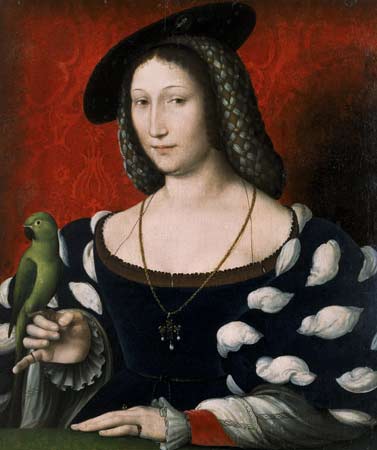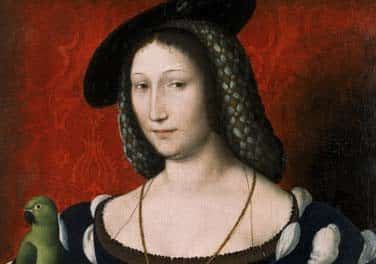
Marguerite de Navarre was born Marguerite d’Angouleme, the daughter of Louise of Savoy and Charles, Count of Angouleme. She was elder sister to the man who became King Francis I of France, and she was a formative influence on Anne Boleyn.
Marguerite grew up away from court in Cognac, where she and Francis were carefully educated in the classics and the arts (Louise of Savoy was considered one of the most brilliant feminine minds in France…of course they would). Members of the royal family were expected to marry for the political convenience of the king, and Marguerite was no exception. She married her first husband, Charles IV of Alençon, when she was seventeen (he was twenty, so at least it was age-appropriate, though he was described as “a laggard and a dolt”). They were central figures at the French court by the time Anne Boleyn arrived (she came with Mary Tudor who married Louis XII in 1514 – and was widowed three months later) and throughout Anne’s service to Queen Claude.
Marguerite wrote many poems and plays. Her most notable works are a classic collection of short stories, the Heptameron, and a remarkably intense religious poem, Miroir de l’âme pécheresse (Mirror of the Sinful Soul), a first-person, mystical narrative of a soul calling out to Christ. It is conjectured that Marguerite may have given Anne a manuscript of Miroir de l’âme pécheresse at some point – we do know that in 1544, nine years after Anne Boleyn’s execution, Anne’s then eleven-year-old daughter Elizabeth translated the poem into English prose presented it to her stepmother, Katherine Parr (also a noted reformist!). Either way, there was a personal connection between the two women that made it incredible hurtful to Anne that Marguerite refused to meet with her in 1532, when Anne accompanied Henry to Calais to seek French support. The visit was a triumph nevertheless (read about it here), but Anne was quietly devastated over the insult.
One other point to be mentioned involves another part of Marguerite’s legacy: after her first husband died in 1525, Marguerite married Henry II of Navarre. She became Queen of Navarre – and their grandson would become Henri IV of France, unifying Catholics and Protestants for a time (Paris vaut bien une messe, after all…).
I will let Marguerite herself close the post, with a short excerpt from the Miroir – one which conjures Anne Boleyn’s later Oh, death, rock me asleep (you can see for yourself here):
How beautiful is death,
That brings to weary me the hour of rest!
Oh! Hear my cry and hasten, Lord, to me,
And put an end to all my misery
***
If you like my posts, you’ll love my books! My Seymour Saga trilogy tells the gripping story of the short-lived dynasty that shaped the Tudor Era. Jane the Quene skews romantic, The Path to Somerset is pure Game of Thrones (without the dragons), and The Boy King is a noir coming-of-age. Get them now through Amazon, Barnes & Noble, Kobo, and Apple, or even your local independent bookstore!

(PS Already read them? Did you love them? Then please review them – even just a stars rating! It makes a huge difference in helping new readers find them and would mean the world to me!)

Be First to Comment